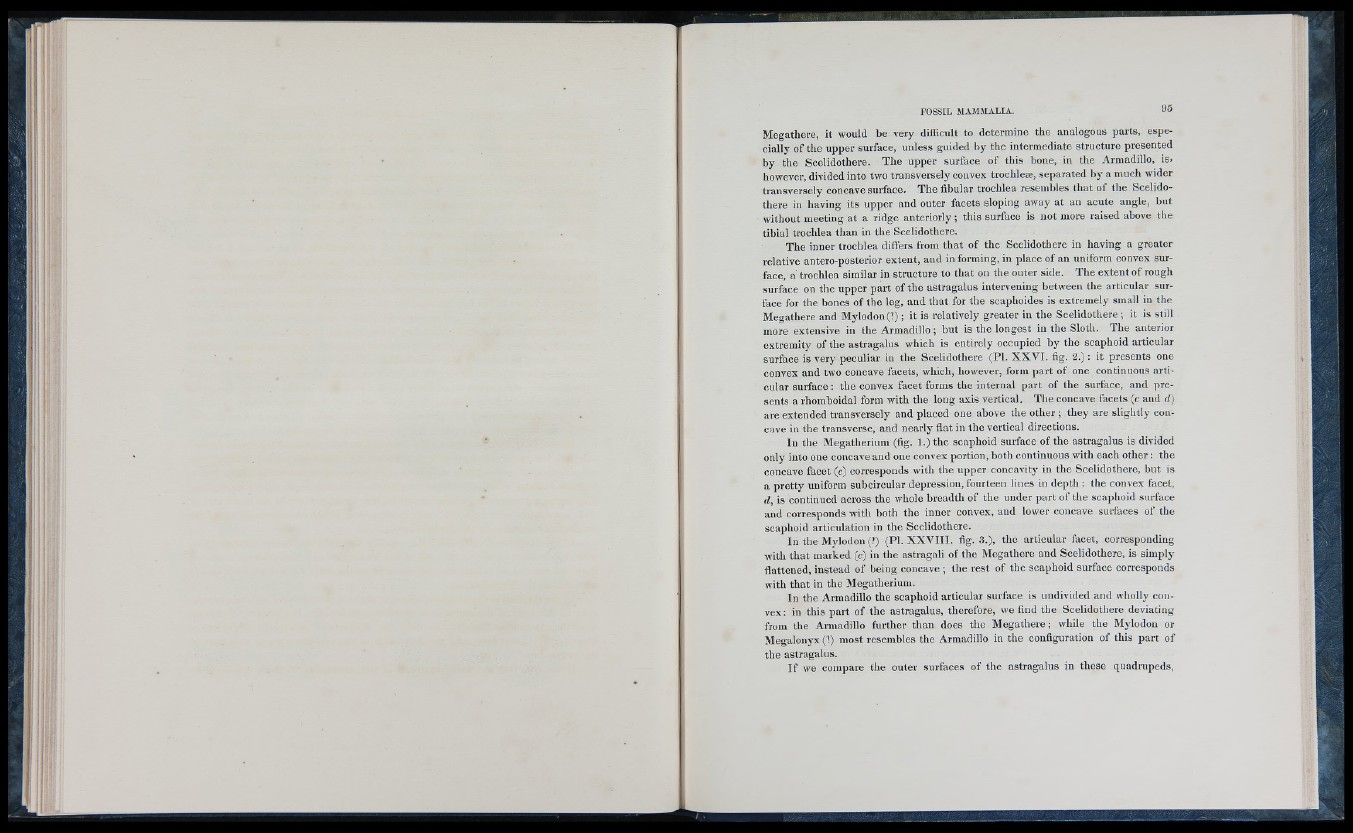
Megatheve, it would be yery difficult to determine the analogous parts, espec
ia lly o f the upper surface, unless guided by the intermediate structure presented
b y the Scelidothere. The upper surface o f this hone, in the Armadillo, is.
however, divided into two transversely convex trochlete, separated by a much wider
transversely concave surface. The fibular trochlea resembles that o f the Scelidothere
in having its upper and outer facets sloping away at an acute angle, but
without meeting at a ridge anteriorly; this surface is not more raised above the
tibial trochlea than in the Scelidothere.
Th e inner trochlea differs from that o f the Scelidothere in having a greater
relative antero-posterior extent, and in forming, in place o f an uniform convex surface,
a trochlea similar in structure to that on the outer side. The extent o f rough
surface on the upper part o f the astragalus intervening between the articular surface
for the bones o f the leg, and that for the scaphoides is extremely small in the
Megathere and Mylodon (?); it is relatively greater in the Scelidothere ; it is still
more extensive in the A rm ad illo ; but is the longest in the Sloth. The anterior
extremity o f the astragalus which is entirely occupied by the scaphoid articular
surface is very peculiar in the Scelidothere (PI. X X V I . fig. 2 .): it presents one
convex and two concave facets, which, however, form part o f one continuous articular
su r fa c e : the convex facet forms the internal part o f the surface, and presents
a rhomboidal form with the long axis vertical. The concave facets (c and d)
are extended transversely and placed one above the other ; they are sligh tly concave
in the transverse, and nearly flat in the vertical directions.
In the Megatherium (fig. 1.) the scaphoid surface o f the astragalus is divided
only into one concave and one convex portion, both continuous with each other : the
concave facet (c) corresponds with the upper concavity in the Scelidothere, but is
a pretty uniform subcircular depression, fourteen line s in depth : the convex facet,
d, is continued across the whole breadth o f the under part o f the scaphoid surface
and corresponds with both the inner convex, and lower concave surfaces o f the
scaphoid articulation in the Scelidothere.
In the Mylodon (?) (PI. X X V I I I . fig. 3.), the articular facet, corresponding
with that marked (c) in tlie astragali o f the Megathere and Scelidothere, is simply
flattened, instead o f being concave ; the rest o f the scaphoid surface corresponds
with that in the Megatherium.
In the Armadillo the scaplioid articular surface is undivided and wholly convex:
in this part of the astragalus, therefore, we find the Scelidothere deviating
from the Armadillo further than does the M eg a th e r e ; while the Mylodon or
Megalonyx (?) most resembles the Armadillo in the configuration o f this part o f
the astragalus.
I f we compare the outer surfaces o f the astragalus in these quadrupeds,